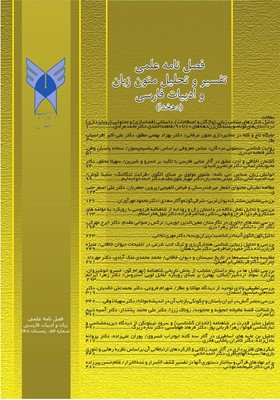بررسی و تحلیل نقش دلاله در داستان زال و رودابه از شاهنامۀ فردوسی با رویکرد به مؤلفه های مددکاری فردی
محورهای موضوعی : متون زبان و ادبیات فارسیفرخ رو شهابی 1 , رضا اشرف زاده 2 * , بتول فخر اسلام 3
1 - دانشجوی دکتری گروه زبان و ادبیات فارسی، واحد مشهد، دانشگاه آزاد اسلامی، مشهد، ایران.
2 - استاد گروه زبان و ادبیات فارسی، واحد مشهد، دانشگاه آزاد اسلامی، مشهد، ایران.
3 - استادیار گروه زبان و ادبیات فارسی، واحد نیشابور، دانشگاه آزاد اسلامی، نیشابور، ایران.
کلید واژه: دلاله, مددکاری فردی, زال و رودابه, شاهنامۀ فردوسی, سیندخت, میانجی گری,
چکیده مقاله :
در متون حماسی، دلاله یا میانجی زنی است که شخصیت های اصلی را در برابر مشکلات راهنمایی می کند و موجب رشد و تعالی آن ها در ابعاد جسمانی و روانی می شود. در دنیای امروز، این نقش برای مددکاران در زندگی روزمره تعریف شده است. وجه اصلی شباهت دلاله و مددکار، یاری رسانی به افراد نیازمند است. در این تحقیق که با استفاده از منابع کتابخانه ای و روش توصیفی- تحلیلی پرداخته شده، نقش دلاله در داستان زال و رودابه از شاهنامۀ فردوسی، با رویکرد به شخصیت سیندخت و مبانی نظری مددکاری فردی کاویده شده است. نتایج تحقیق نشان می دهد که اصلی ترین رسالت سیندخت در داستان، تضمین پیوند میان زال و رودابه و فراهم آوردن بسترهای لازم برای زاده شدن رستم و جهت دهی به مسیر حماسه است. همچنین، او با شخصیت شناسی دقیق و آسیب شناسی مشکل و بحران پیش آمده، مانع از شکل گیری نبردی خونین میان ایرانیان و حکومت کابل شده است. در این داستان، بازخوانی خویشکاری های سیندخت، مبین حضور چشم گیر زنان در عرصه های سیاسی- اجتماعی (نقش فراجنسیتی و ورای هنجارهای موجود) و نیز، نقش آفرینی در مسائل عاشقانه (نقش سنتی) است. سیندخت نمایندۀ زنی پویا و تأثیرگذار در بهبود مناسبات بینا فردی و اجتماعی است. افزون بر سیندخت، زن نامه رسان هم در آغاز داستان، زال و رودابه را به هم نزدیک کرده و دل آن ها را به هم پیوند زده است.
In rich and epic texts, there is a broker or mediator who guides the main characters in the face of difficulties and promotes their growth in physical and psychological dimensions. In today's world, this role is intended for helpers in their daily lives. The key to resembling brokers and helpers is helping people in need. This study, which uses library resources and a descriptive-analytic approach, explores the role of Zale and Roodabeh in Ferdowsi's Shahnameh, with an approach to Sindhokht's personality and the theoretical foundations of individual assistance. The results of the research show that the main mission of Sindhokht in the story is to ensure the connection between Zal and Roodabeh and to provide the necessary background for the birth of Rustam and the direction of the epic path. He has also prevented the formation of a bloody battle between the Iranians and the Kabulis, with a detailed personality and the pathology of the problem and crisis. In this story, the reinterpretation of the Siddiqui relatives illustrates the significant presence of women in transgender and social currents. Sindhokht represents a dynamic and influential woman in organizing interpersonal and social relationships. In addition to Sindhokht, another woman at the beginning of the story brings Zal and Rudaba together and ties them together.

